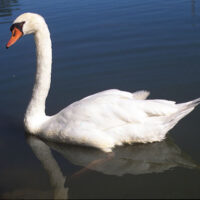 Purdue University - Extension - Forestry and Natural Resources
Purdue University - Extension - Forestry and Natural Resources
Got Nature? Blog
Wild Bulletin, Indiana Department of Natural Resources (DNR) Fish and Wildlife: March is the beginning of peak nesting season for Indiana’s state-endangered trumpeter swan. During the nesting season, it is possible to see trumpeter swans in the northern third of the state, especially Lake, Laporte, Kosciusko, LaGrange, Noble, Steuben, and St. Joseph counties, where they have ample habitat. Hunted to near extinction in the 1900s, the species has made great strides in population numbers, largely due to the passage of the Migratory Bird Treaty Act. Large, open bodies of shallow water with abundant aquatic plants are the preferred habitat of trumpeter swans, and there is potential to see the number of trumpeters increase in northern Indiana; however, the species’ recovery in Indiana isn’t out of the water yet.
Lake, Laporte, Kosciusko, LaGrange, Noble, Steuben, and St. Joseph counties, where they have ample habitat. Hunted to near extinction in the 1900s, the species has made great strides in population numbers, largely due to the passage of the Migratory Bird Treaty Act. Large, open bodies of shallow water with abundant aquatic plants are the preferred habitat of trumpeter swans, and there is potential to see the number of trumpeters increase in northern Indiana; however, the species’ recovery in Indiana isn’t out of the water yet.
Loss of habitat is the No. 1 reason for species decline across the globe, with the presence of invasive species being the second largest reason. Invasive mute swans throughout Indiana pose a threat to trumpeter swans. Mute swans are an aggressive bird that can negatively impact trumpeter swans through direct killing of adults and their young, outcompeting them for available nesting spaces, and destroying the vegetation on our bodies of water. Managing mute swans has been shown to be an effective method for increasing trumpeter swans in other states.
Use these helpful tips to distinguish between the native trumpeter swan and the invasive mute swan:
- Trumpeter swans have black bills and legs. Mute swans have orange bills with black knobs.
- Trumpeter swans hold their necks straight when swimming in water and flying. Mute swans hold their necks in an “S” shape.
- Trumpeter swan numbers increase in winter in southwest Indiana and in the spring can be more common in the northern third of Indiana. Mute swans can occur statewide but are more common in the north.
Learn more about our endangered wildlife or find more information on mute swan management on our website.
To learn more about mute swans and their impact, please visit Indiana Department of Natural Resources: Mute Swans.
Resources:
Managing Woodlands for Birds Video, Purdue Extension-Forestry and Natural Resources (FNR) YouTube Channel
Breeding Birds and Forest Management: the Hardwood Ecosystem Experiment and the Central Hardwoods Region, The Education Store
The Birders’ Dozen, Profile: Baltimore Oriole, Indiana Woodland Steward
Ask An Expert, Playlist, Purdue Extension – FNR YouTube channel
It’s For the Birds, Indiana Yard and Garden-Purdue Consumer Horticulture
Birds and Residential Window Strikes: Tips for Prevention, The Education Store, Purdue Extension resource center
No Room at the Inn: Suburban Backyards and Migratory Birds, Education Store, Purdue Extension resource center
Hardwood Ecosystem Experiment – Wildlife Responses to Timber Harvesting, The Education Store
Subscribe, Purdue Extension – FNR YouTube Channel
Hunting and Trapping Guide, Indiana Department of Natural Resources
Indiana Department of Natural Resources

Recent Posts
- Publication – Introduction to White-tailed Deer Impacts on Indiana Woodlands
Posted: April 28, 2024 in Forestry, Land Use, Plants, Publication, Wildlife, Woodlands - Publication – Understanding White-tailed Deer and Their Impact on Indiana Woodlands
Posted: in Forestry, Land Use, Plants, Publication, Wildlife, Woodlands - Publication – Monitoring White-tailed Deer and Their Impact on Indiana Woodlands
Posted: in Forestry, Land Use, Plants, Publication, Wildlife, Woodlands - Publication – Managing White-tailed Deer Impacts on Indiana Woodlands
Posted: in Forestry, Land Use, Plants, Publication, Wildlife, Woodlands - Report Spotted Lanternfly – Purdue Landscape Report
Posted: April 10, 2024 in Alert, Forestry, Invasive Insects, Plants, Wildlife, Woodlands - Declining Pines of the White Variety – Purdue Landscape Report
Posted: in Alert, Disease, Forestry, Plants, Wildlife, Woodlands - Are you seeing nests of our state endangered swan? – Wild Bulletin
Posted: April 9, 2024 in Alert, Forestry, How To, Wildlife - Cicadas in Spring! – Purdue Landscape Report
Posted: in Forestry, Plants, Safety, Wildlife - New Deer Impact Toolbox
Posted: April 7, 2024 in Forestry, Land Use, Plants, Publication, Safety, Wildlife, Woodlands - 2024-25 Fishing Guide now available – Wild Bulletin
Posted: April 4, 2024 in Alert, Aquaculture/Fish, Aquatic/Aquaculture Resources, How To, Ponds, Wildlife
Archives
Categories
- Alert
- Aquaculture/Fish
- Aquatic/Aquaculture Resources
- Ask the Expert
- Christmas Trees
- Community Development
- Disease
- Drought
- Forestry
- Forests and Street Trees
- Gardening
- Got Nature for Kids
- Great Lakes
- How To
- Invasive Animal Species
- Invasive Insects
- Invasive Plant Species
- Land Use
- Natural Resource Planning
- Nature of Teaching
- Plants
- Podcasts
- Ponds
- Publication
- Safety
- Timber Marketing
- Uncategorized
- Urban Forestry
- Webinar
- Wildlife
- Wood Products/Manufacturing
- Woodland Management Moment
- Woodlands